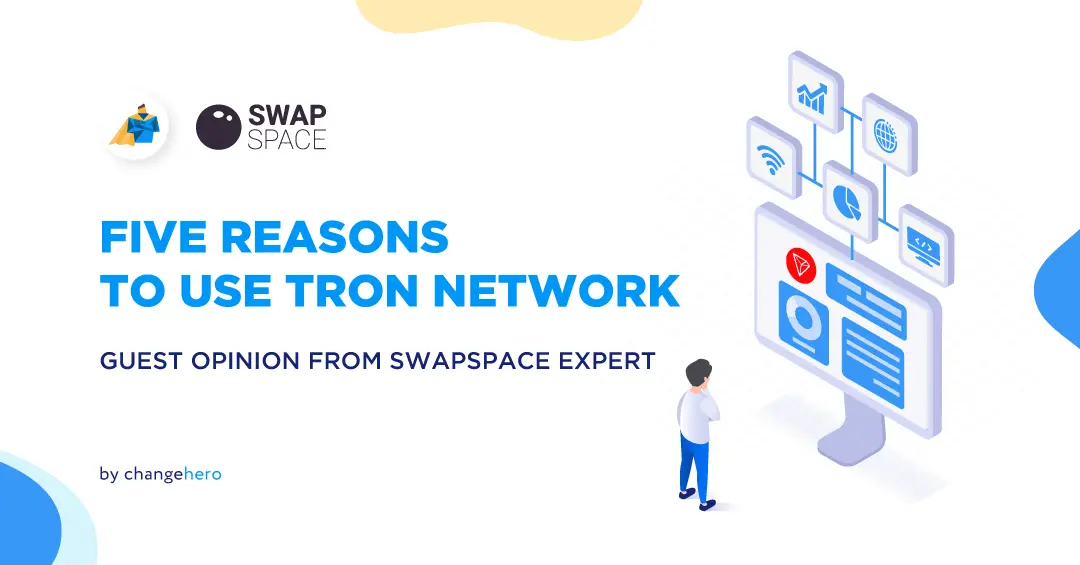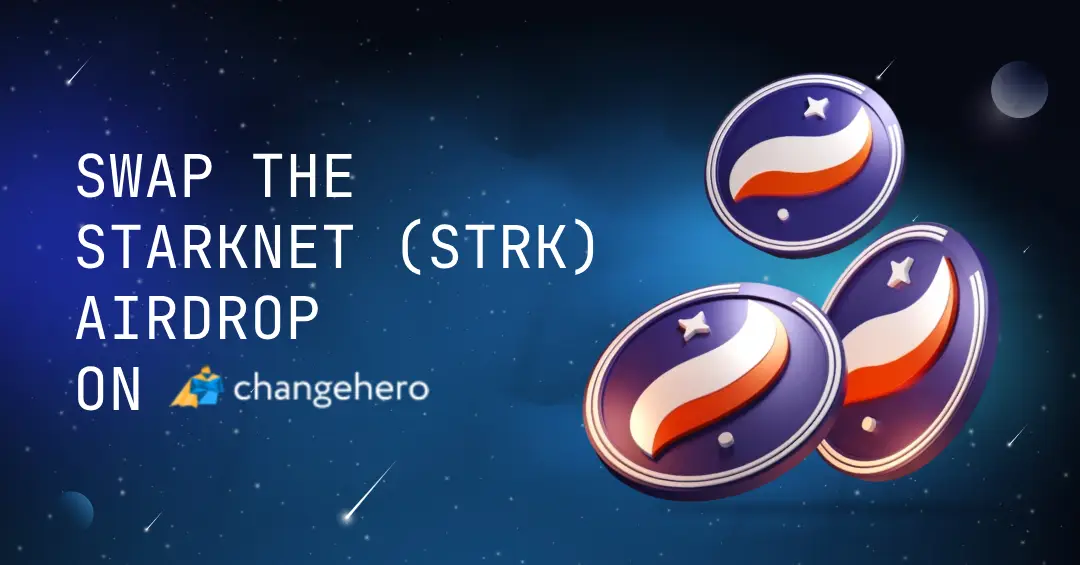Cryptocurrencies were made to be used as a peer-to-peer cash but evolved into fully-fledged platforms with thousands of possible applications. However, both with Bitcoin and Ethereum the solutions were far from perfect and encountered scalability issues and bloating costs. ChangeHero and the CMO of SwapSpace John Steinmuller make a case for one of the thousands of alternatives — TRON Network.
Why Should You Use TRON? Consider These Five Points
Lower Transaction Costs
In both Ethereum and TRON, not only transfers incur a fee for inclusion in the next block. Even virtual machine and smart contract calls require you to pay. Since transaction fees work like an auction, miners or validators prioritize those who give a higher tip. It is denominated in the network’s native token — ETH and TRX respectively.
There are two aspects that drive the Ethereum network fees up or down. Namely, network load and the price of the native token. In the bull market of 2021, for Ethereum, average transaction fee was 30 to 60 USD worth of ETH. These days, it is closer to $3 to $6 dollars, which is significantly lower but still can be a lot. Meanwhile, TRON uses a slightly different fee mechanic: below a certain threshold the transactions and TVM calls are free. Should you go above it, you need to stake as little as 0.4 TRX ($0.0028).
Decentralized Finance
Without any doubt, Ethereum is the true home to the decentralized finance industry. After all, at the moment it has the highest total value locked metric at $40 billion USD. The runner-ups compete for only a fraction of this metric.
TRONScan chain explorer indicates that over $11 billion is locked into the DeFi protocols on TRON. Lending protocol JustLend, TRX Staking Governance and decentralized exchange SUN.io take up the most of it. There may not be as many protocols to choose from (531 vs. 10(!) according to DefiLlama) but sometimes, less is more. TRON Ecosystem covers pretty much all the ground DeFi has to offer: lending, staking, stablecoins, swapping, farming — you name it.
Stablecoins
These crypto tokens tied to the value of USD and other fiat currencies are extremely widespread. Users value them for predictable value with real-world reference. However, as transacting on Ethereum would at times be unpredictably costly, users moved on to other networks — including TRON.
For example, take the most popular stablecoin protocol, Tether USD. It has $66 million USDT in the Ethereum contract and $33 million USDT on TRON. However, the average daily volume of transfers is higher on the latter: $9 million USDT-TRC20 versus $3 million USDT-ERC20 daily.
And of course, Tether is not the only stablecoin issuer offering their services on TRON. You can choose any from semi-centralized USDT and USDC to native algorithmic USDD and USDJ.
Transaction Throughput
Payment providers, such as Visa and MasterCard, became as popular as they are thanks to their near instantaneous settlements. Would you want to wait up to a minute or two at the checkout if you wanted to pay with cryptocurrency?
Well, unfortunately, this is the case with Ethereum. New blocks are added to its chain every 15 seconds but if your transaction does not get included in the next block, you will have to wait for the next one, and maybe even a little after that. Not to mention, for a transaction to be considered really finalized, it takes at least three blocks since inclusion.
The TRON blockchain adds blocks every three seconds. On average, it processes 75–100 transactions per second, which is more than ten times more than Ethereum.
Developer-Friendly
Finally, if you are interested in building decentralized apps and working with smart contracts, TRON is a surprisingly good option. You can start working with tokens with the TRC-10 standard and move on to smart contracts when you have a better understanding of Solidity. TRON mainnet implementation is written in Java and it uses JavaScript-based tools for dApp interfaces.
By the time you develop fully-fledged blockchain applications, you will be able to migrate your apps to Ethereum. In architecture, the two networks are somewhat similar — but will you want to give up the ease of use and low costs?
Guest Opinion from SwapSpace Expert: John Steinmuller, SwapSpace CMO
ChangeHero (CH): Is TRX popular with the SwapSpace community?
John Steinmuller (JS): Yes — according to our internal statistics, Tron is a fairly popular coin among our community. TRX is traded quite actively via SwapSpace. Also, our TRX Exchange and Price Prediction pages, where the customers go for the information on this coin, are among the more visited ones in their categories. All of this signals a significant level of interest from our user base.
CH: Do you think that Tron Network has potential for future development? Why?
JS: There’s definitely a lot of potential there. It’s reflected in the numbers: recently, Tron placed second in the TVL rankings worldwide, overtaking BNB Chain, which shows that both developers’ and users’ interest in Tron keeps growing. Speaking of developers, they are drawn to Tron: there is news of new projects deployed within the Tron ecosystem seemingly every month, which also bodes well for the network’s future. The human factor is another reason: Tron founder Justin Sun obviously has a strong personality as well as ambition, which, while controversial, usually translates into a real ability to drive development.
CH: What are the advantages of using the Tron Network?
JS: The main advantages of using TRX are its transaction speed and low fees. They give rise to another advantage which is a network effect: the more people use Tron Network (due to fees and speed), the faster its popularity spreads. Hence, it’s advantageous to have some TRX or TRC tokens since more and more merchants and organizations accept — and even prefer — them for payments.
From a developer’s point of view, another benefit is the ease of token creation on the Tron Network.
Finally, if we look at it more globally, Proof-of-Stake (dPoS in this case) chains are less harmful to the environment than PoW, so if you’re someone who cares about the impact of using crypto, this is definitely another advantage.
CH: Can Tron outperform Ethereum? Overtake it?
JS: Not to take away from all its achievements, but Tron has a long way to go before that happens if it ever does. For example, if you take a look at the TVL rankings mentioned above, you’ll see that Ethereum is really, really far ahead of everyone. It’s a huge gap to close, despite very strong efforts from Tron. Of course, there is a possibility that Ethereum slows down its development, or, for instance, The Merge will not go as planned, or people will lose faith in ETH. Any of these events would definitely make outperforming it easier for Tron, but until that happens, let’s not get ahead of ourselves. And, in any case, there’s no shame in being behind Ethereum — most networks are.
Conclusion
We thank our partners in SwapSpace and John for providing us with insightful commentary. All in all, TRON is one of the go-to smart contract platforms worth your time, whether you want to send and receive stablecoins or build value in crypto. Subscribe to ChangeHero and SwapSpace in social media for more news and updates from the crypto space!








